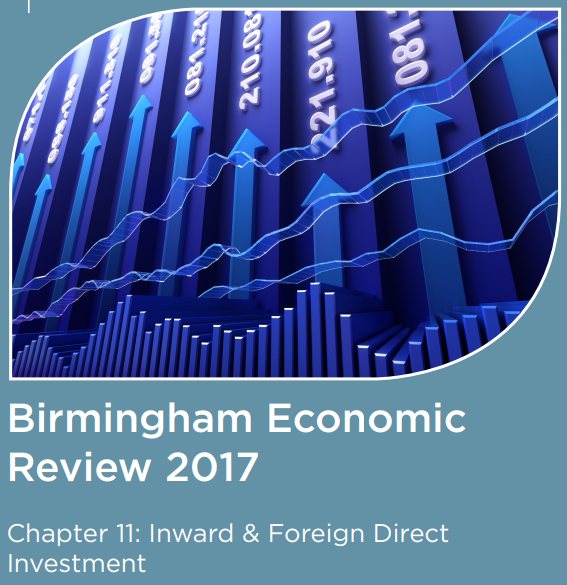The Birmingham Economic Review was produced in October 2017 by City-REDI, the Greater Birmingham Chambers of Commerce and the West Midlands Growth Company.
The review highlights the current strengths and weakness of the Birmingham economy, as well as looking at the opportunities and threats that might impact upon it in the future.
This is a commentary on Chapter 11 of the Review, Inward & Foreign Direct
Investment:
As has been documented in both local and national press, the region covered by the GBSLEP has done very well on attracting inward investment into the region. While there are some well-known examples, such as the continued expansion and development of JLR, and HSBC, these are in many ways just the tip of the iceberg, with many less glamorous investments underpinning the success of the region.
Between 2011 and 2015, the latest year of official data, there were 549 inward investment projects in the region.
Inward investment by employment across the West Midlands
| Black Country | Coventry & Warwickshire | Greater Bham & Solihull | |
| No. of Jobs | 2,565 | 11,405 | 33,830 |
| % | 5.4% | 20.3% | 60.1% |
Not surprisingly this is dominated by the GBSLEP region, but what is noticeable is the low percentage that occurs in the Black Country, accounting for only 5.4% of the inward investment (in terms of employment), that comes into the “3 LEP” region.
The data offer an interesting commentary on the contribution that inward investment makes to productivity locally. If one takes as a benchmark that foreign firms have on average 15-20% higher productivity than local firms[1], and that a high proportion of inward investment for the WMCA region is in sectors with above average productivity, then this indicates the importance that attracting and retaining inward investment has for the local economy.
In general, the region attracts inward investment in sectors of above average productivity, and in sectors where the region compares favourably with others. This emphasises that the region attracts inward investment by “building on strength”, and it emphasises the wisdom of a sector based approach that underpinned the work of Marketing Birmingham (Now the WM Growth Company).
Such sectors are also above average in terms of innovation, capital intensity and spending on R&D.
The distribution across sectors paints an equally familiar story. Not surprisingly this is dominated by advanced engineering, across motor vehicles and transport, and electronic equipment. Basic metals still attract a degree of inward investment, as do food and drink, and more recently, financial services – a trend that looks set to continue.
The major challenges and opportunities for Birmingham economy can be summarized as follows:
Challenges:
1) In general, policy makers and inward investment agencies chase inward investment on the basis of two contributions that inward investment can make to the local economy:
- Generating employment for hitherto under-employed labour
- Introducing new technology
These, however, are often independent (or even orthogonal to each other), in that projects which create employment opportunities for those people unemployed, are typically in more low skill activities with relatively standard technology. The food and drink sector is an excellent example here. Inward investors in this sector are typically more productive than local firms, but in a sector with productivity below the average for the region. In contrast, capital intensive or technology intensive activities can boost productivity, but provide fewer employment opportunities. Indeed it may even exacerbate skill shortages.
2) It is impossible to discuss the prospects for inward investment in the region in the absence of a discussion regarding Brexit. At the moment, aggregate inward investment figures for both the UK overall and the region are holding up, but with higher proportions in the acquisition of existing assets, whether those be M&A activity or the acquisition of real estate. Investment in new capacity is slowing. It is undeniable that some firms seek to re-orientate activity away from the UK, and other potential investors will be put off, especially by a hard Brexit.
Opportunities:
- To build on existing large infrastructure projects. These are independent of Brexit but should attract inward investment by companies in engineering, and professional service firms.
- To continue to develop the excellent proposition that the region has for inward investment, but explore new sectors as sources of new investment.
- To explore sectors where Brexit may encourage reshoring, or where there are other opportunities for reshoring, based for example on a new long term long lower value of sterling.
- To work with existing employers, and skill providers to build supply chain resilience in such sectors, to support OEMs and tier 1 suppliers who may seek to repatriate activity after Brexit.
Footnotes:
[1] Clearly these estimates vary depending on whether one uses labour productivity or total factor productivity, the extent to which one controls for factors such as age and size, and for sectoral differences, but the essential result has been found to be robust over a long period of time and a wide range of studies.
To download a copy of the Birmingham Economic Review, please click here.
This commentary was written by Professor Nigel Driffield, Department of Strategy & International Business, Warwick Business School
Disclaimer:
The views expressed in this analysis post are those of the authors and not necessarily those of City-REDI or the University of Birmingham
To sign up for our blog mailing list, please click here.

